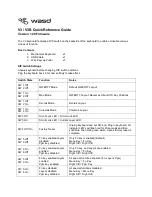
64
Appendix
Preset Voice List
Preset Voice List
CLP-470/440/S408/S406
:
Yes
—:
No
Voice Name
Touch
Response
Stereo
Sampling
Key-Off
Sampling
Sustain
Sampling
String
Resonance
Voice description
GRAND PIANO1
This sound was sampled from a concert grand piano. It uses
different samples depending on the strength of your playing
and produces smoother tonal changes. Even the tonal changes
produced by the damper pedal and the subtle sounds of
releasing a key are reproduced. The sympathetic vibration
(string resonance) that occurs among the strings of an acoustic
piano has also been simulated. Suitable not only for classical
compositions but also for piano pieces of any style.
VARIATION
Standard piano with a soft and warm tone. Good for playing
ballads.
GRAND PIANO2
—
Mellow piano sound with gradual attack. Good for quiet and
slow music.
VARIATION
Warm and soft piano sound. Good for relaxing music.
GRAND PIANO3
Bright piano sound. Good for clear expression and “cutting
through” other instruments in an ensemble.
VARIATION
A slightly brighter piano sound than the Grand Piano. Good for
popular styles.
GRAND PIANO4
—
—
—
Spacious and clear piano with bright reverb. Good for popular
music.
VARIATION
—
A solid, bass-heavy piano sound. Good for making your
performance more dynamic.
E.PIANO1
—
—
—
—
An electronic piano sound created by FM synthesis. Extremely
“musical” response with varying timbre according to keyboard
dynamics. Good for standard popular music.
VARIATION
—
—
—
—
A synth-generated type electronic piano sound often heard in
popular music. Used in the Dual mode it blends well with an
acoustic piano Voice.
E.PIANO2
—
—
—
The sound of an electric piano using hammer-struck metallic
“tines.” Soft tone when played lightly, and an aggressive tone
when played hard.
VARIATION
—
—
—
—
A slightly different electric piano sound often heard in rock and
popular music.
HARPSICHORD
—
—
—
The definitive instrument for baroque music. Since harpsichord
uses plucked strings, there is no touch response. There is,
however, a characteristic additional sound when the keys are
released.
VARIATION
—
—
—
Mixes the same Voice an octave higher for a more brilliant tone.
PIPE ORGAN
—
—
—
—
This is a typical pipe organ sound (8 feet + 4 feet + 2 feet).
Good for sacred music from the Baroque period.
VARIATION
—
—
—
—
This is the organ’s full coupler sound often associated with
Bach’s “Toccata and Fugue.”
JAZZ ORGAN
—
—
—
—
—
The sound of a “tonewheel” type electric organ. Often heard in
jazz and rock music. The rotary speed of the “ROTARY SP”
effect can be switched by using the left pedal.
VARIATION
—
—
—
—
—
The sound of a “tonewheel” type electric organ without attacks.
Select the normal or variation Voice depending on the tunes.
The rotary speed of the “ROTARY SP” effect can be switched by
using the left pedal.
STRINGS
—
—
—
Stereo-sampled, large-scale strings ensemble with realistic
reverb. Try combining this Voice with piano in the Dual mode.
VARIATION
—
—
—
Spacious strings ensemble with a slow attack. Try combining
this Voice with a piano or electric piano in the Dual mode.
CHOIR
—
—
—
—
A big, spacious choir Voice. Perfect for creating rich harmonies
in slow pieces.
VARIATION
—
—
—
—
A choir Voice with a slow attack. Try combining this Voice with a
piano or electric piano in the Dual mode.
















































